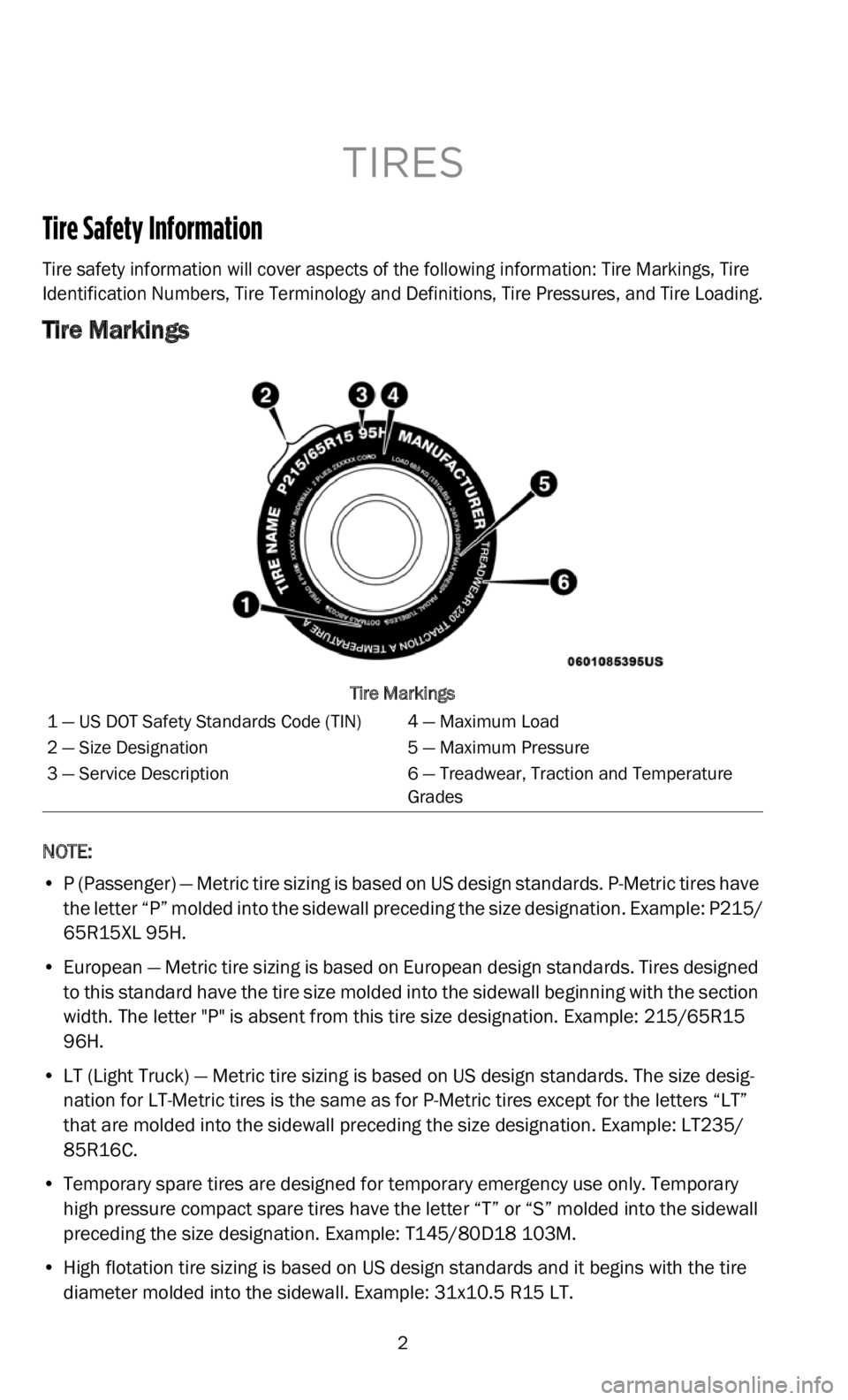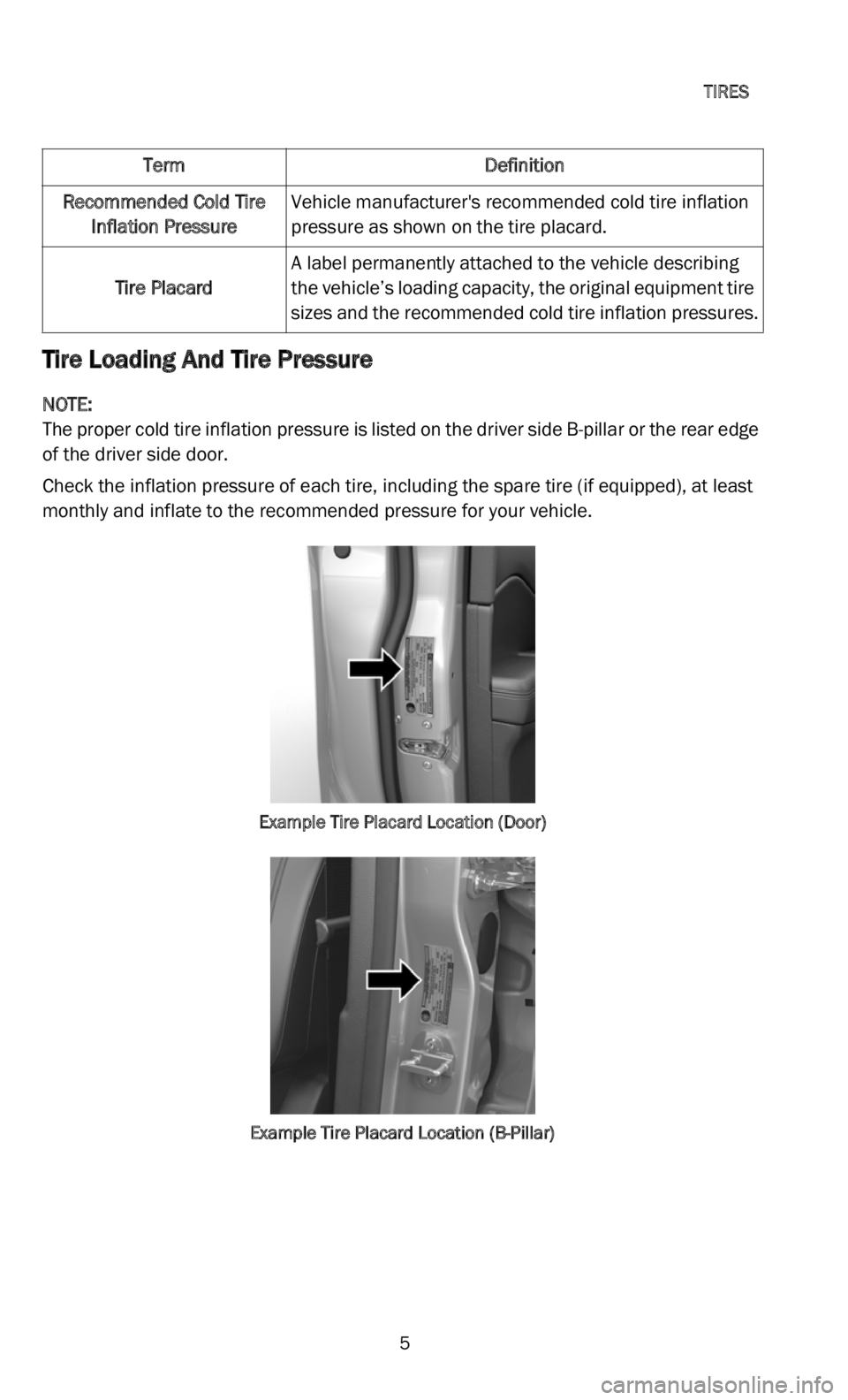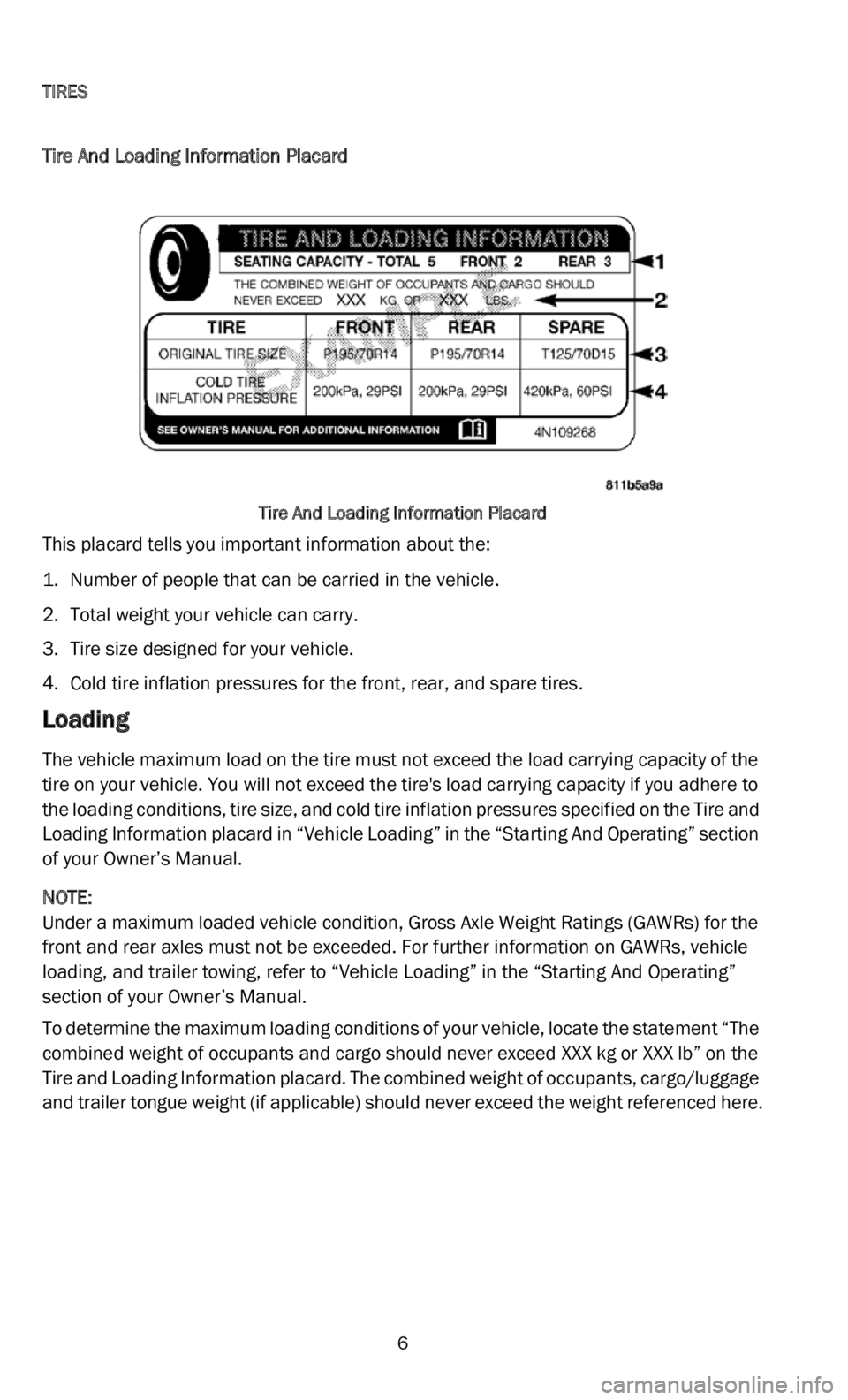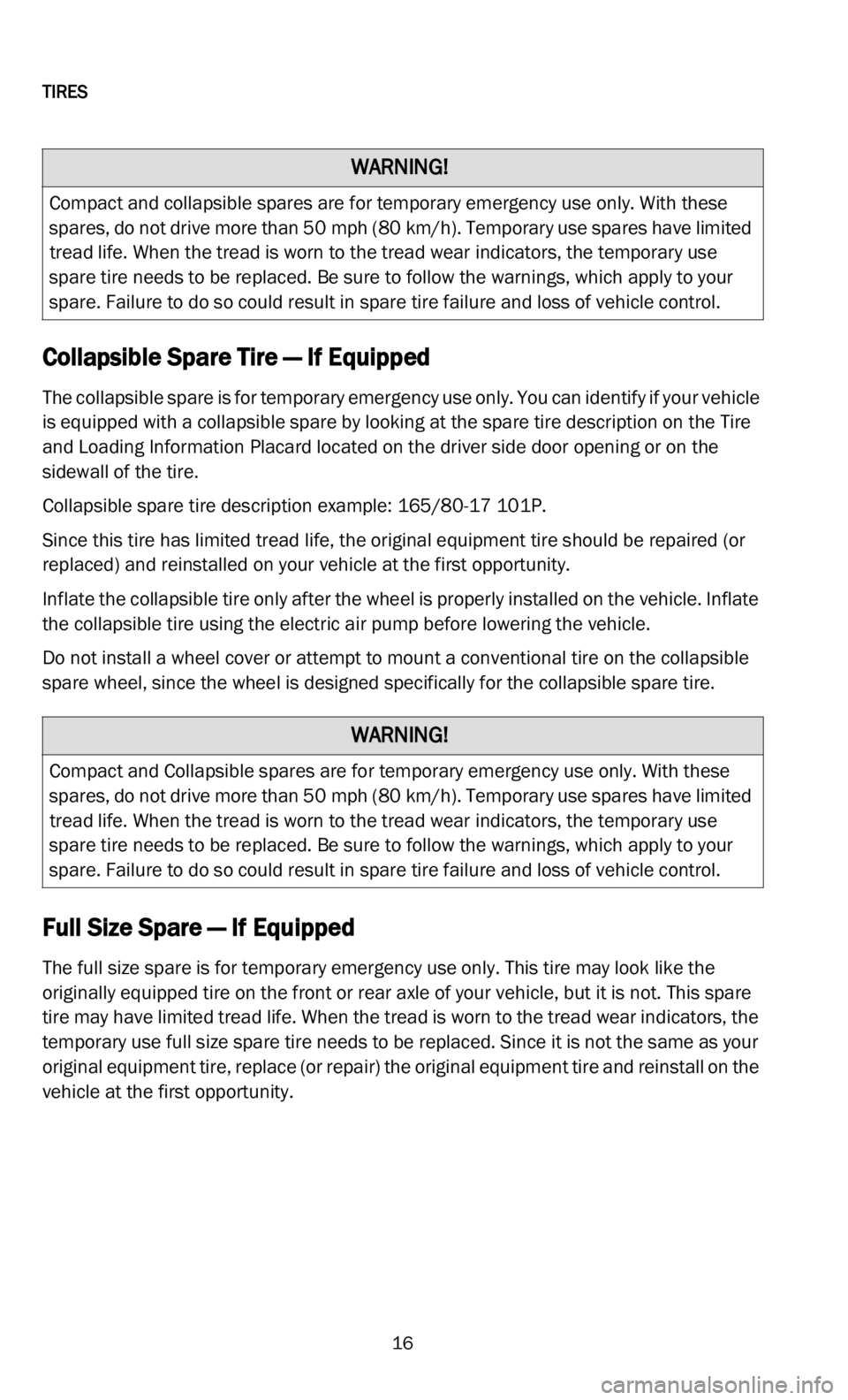spare tire DODGE CHALLENGER 2022 Vehicle Warranty
[x] Cancel search | Manufacturer: DODGE, Model Year: 2022, Model line: CHALLENGER, Model: DODGE CHALLENGER 2022Pages: 200, PDF Size: 6.72 MB
Page 3 of 200

2
TIRES
Tire Safety Information
Tire safety information will cover aspects of the following information: Tire Markings, Tire
Identification Numbers, Tire Terminology and Definitions, Tire Pressures, and Tire Loading.
Tire Markings
Tire Markings
NOTE:
• P (Passenger) — Metric tire sizing is based on US design standards. P-Metric tires haveth
e letter “P” molded into the sidewall preceding the size designation. Example: P215/
65R15XL 95H.
• European — Metric tire sizing is based on European design standards. Tires designed to
this standard have the tire size molded into the sidewall beginning with the section
width. The letter "P" is absent from this tire size designation. Example: 215/65R15
96H.
• LT (Light Truck) — Metric tire sizing is based on US design standards. The size desig -
n a
tion for LT-Metric tires is the same as for P-Metric tires except for the letters “LT”
th a
t are molded into the sidewall preceding the size designation. Example: LT235/
85R16C.
• Temporary spare tires are designed for temporary emergency use only. Temporary hi
gh pressure compact spare tires have the letter “T” or “S” molded into the sidewall
preceding the size designation. Example: T145/80D18 103M.
• High flotation tire sizing is based on US design standards and it begins with the tire di
ameter molded into the sidewall. Example: 31x10.5 R15 LT.
1 — US DOT Safety Standards Code (TIN) 4 — Maximum Load
2 — Size Designation 5 — Maximum Pressure
3 — Service Description 6 — Treadwear, Traction and Temperature
Gra
des
Page 4 of 200

TIRES
3
Tire Sizing Chart
EXAMPLE:
Example Size Designation: P215/65R15XL 95H, 215/65R15 96H, LT235/85R16C,
T1 4
5/80D18 103M, 31x10.5 R15 LT
P = Passenger car tire size based on US design standards, or
"....blank...." =
Passenger car tire based on European design standards, or
LT = Light Truck tire based on US design standards, or
T
or S = Temporary spare tire or
3 1 =
Overall diameter in inches (in)
2 1
5, 235, 145 =
Section width in millimeters (mm)
65, 85, 80 = Aspect ratio in percent (%)
• Ra
tio of section height to section width of tire, or 10
.5 = Section width in inches (in)
R = Construction code
• "R" means radial construction, or
• "D
" means diagonal or bias construction
1 5
, 16, 18 = Rim diameter in inches (in)
S e
rvice Description:
95 = Load Index
• A
numerical code associated with the maximum load a tire can carry
H
= Speed Symbol
• A symbol indicating the range of speeds at which a tire can carry a load corre -
s p
onding to its load index under certain operating conditions
• The maximum speed corresponding to the speed symbol should only be achieved un
der specified operating conditions (i.e., tire pressure, vehicle loading, road condi -
tions, and posted speed limits)
Load Identification:
Absence of the following load identification symbols on the sidewall of the tire
in d
icates a Standard Load (SL) tire:
• XL = Extra load (or reinforced) tire, or
• LL =
Light load tire or
• C, D, E, F, G =
Load range associated with the maximum load a tire can carry at a
specified pressure
Maximum Load –
Maximum load indicates the maximum load this tire is designed to
carry
Maximum Pressure –
Maximum pressure indicates the maximum permissible cold tire
inflation pressure for this tire
Page 6 of 200

TIRES
5
Tire Loading And Tire Pressure
NOTE:
The proper cold tire inflation pressure is listed on the driver side B-pillar or the rear edge
of
the driver side door.
Check the inflation pressure of each tire, including the spare tire (if equipped), at least
mo n
thly and inflate to the recommended pressure for your vehicle.
Example Tire Placard Location (Door)
Example Tire Placard Location (B-Pillar)
Recommended Cold Tire Inflation Pressure Vehicle manufacturer's recommended cold tire inflation
pre
ssure as shown on the tire placard.
Tire Placard A label permanently attached to the vehicle describing
th
e
vehicle’s loading capacity, the original equipment tire
sizes and the recommended cold tire inflation pressures.
Term Definition
Page 7 of 200

TIRES
6
Tire And Loading Information Placard
Tire And Loading Information Placard
This placard tells you important information about the:
1. Number of people that can be carried in the vehicle.
2.
Total weight your vehicle can carry.
3 .
Tire size designed for your vehicle.
4 .
Cold tire inflation pressures for the front, rear, and spare tires.
Loading
The vehicle maximum load on the tire must not exceed the load carrying capacity of the
tire on your vehicle. You will not exceed the tire's load carrying capacity if you adhere to
the loading conditions, tire size, and cold tire inflation pressures specified on the Tire and
Loading Information placard in “Vehicle Loading” in the “Starting And Operating” section
of your Owner’s Manual.
NOTE:
Under a maximum loaded vehicle condition, Gross Axle Weight Ratings (GAWRs) for the
f r o
nt and rear axles must not be exceeded. For further information on GAWRs, vehicle
loading, and trailer towing, refer to “Vehicle Loading” in the “Starting And Operating”
section of your Owner’s Manual.
To determine the maximum loading conditions of your vehicle, locate the statement “The
co m
bined weight of occupants and cargo should never exceed XXX kg or XXX lb” on the
Tire and Loading Information placard. The combined weight of occupants, cargo/luggage
and trailer tongue weight (if applicable) should never exceed the weight referenced here.
Page 14 of 200

TIRES
13
Life Of Tire
The service life of a tire is dependent upon varying factors including, but not limited to:
• D riving style.
•
Tire pressure - Improper cold tire inflation pressures can cause uneven wear patterns
t
o develop across the tire tread. These abnormal wear patterns will reduce tread life,
resulting in the need for earlier tire replacement.
• D istance driven.
•
Performance tires, tires with a speed rating of V or higher, and Summer tires typically
h
ave a reduced tread life. Rotation of these tires per the vehicle scheduled mainte -
nance is highly recommended.
Keep dismounted tires in a cool, dry place with as little exposure to light as possible.
P r
otect tires from contact with oil, grease, and gasoline.
Replacement Tires
The tires on your new vehicle provide a balance of many characteristics. They should be
inspected regularly for wear and correct cold tire inflation pressures. FCA US LLC strongly
recommends that you use tires equivalent to the originals in size, quality and
performance when replacement is needed. Refer to the paragraph on “Tread Wear
Indicators” in this section. Refer to the Tire and Loading Information placard or the
Vehicle Certification Label for the size designation of your tires. The Load Index and
Speed Symbol for your tires will be found on the original equipment tire sidewall.
See the Tire Sizing Chart example found in the “Tire Safety Information” section of this
ma
nual for more information relating to the Load Index and Speed Symbol of a tire.
It is recommended to replace the two front tires or two rear tires as a pair. Replacing just
o n
e tire can seriously affect your vehicle’s handling. If you ever replace a wheel, make
sure that the wheel’s specifications match those of the original wheels.
It is recommended you contact an authorized tire dealer or original equipment dealer with
a n
y questions you may have on tire specifications or capability. Failure to use equivalent
replacement tires may adversely affect the safety, handling, and ride of your vehicle.
WARNING!
Tires and the spare tire should be replaced after six years, regardless of the remaining
tread. Failure to follow this warning can result in sudden tire failure. You could lose
control and have a collision resulting in serious injury or death.
Page 16 of 200

TIRES
15
Snow Tires
Some areas of the country require the use of snow tires during the winter. Snow tires can
be identified by a “mountain/snowflake” symbol on the tire sidewall. If you need snow tires, select tires equivalent in size and type to the original
equipment tires. Use snow tires only in sets of four; failure to do so may
ad
versely affect the safety and handling of your vehicle.
Snow tires generally have lower speed ratings than what was originally equipped with
y o
ur vehicle and should not be operated at sustained speeds over 75 mph (120 km/h).
F o
r speeds above 75 mph (120 km/h) refer to original equipment or an authorized tire
d e
aler for recommended safe operating speeds, loading and cold tire inflation
pressures.
While studded tires improve performance on ice, skid and traction capability on wet or
d r
y surfaces may be poorer than that of non-studded tires. Some states prohibit studded
tires; therefore, local laws should be checked before using these tire types.
Spare Tires — If Equipped
Spare Tire Matching Original Equipped Tire And Wheel —
If Equipped
Your vehicle may be equipped with a spare tire and wheel equivalent in look and function
to the original equipment tire and wheel found on the front or rear axle of your vehicle.
This spare tire may be used in the tire rotation for your vehicle. If your vehicle has this
option, refer to an authorized tire dealer for the recommended tire rotation pattern.
Compact Spare Tire — If Equipped
The compact spare is for temporary emergency use only. You can identify if your vehicle
is equipped with a compact spare by looking at the spare tire description on the Tire and
Loading Information Placard located on the driver side door opening or on the sidewall
of the tire. Compact spare tire descriptions begin with the letter “T” or “S” preceding the
size designation. Example: T145/80D18 103M.
T, S = Temporary Spare Tire
Since this tire has limited tread life, the original equipment tire should be repaired (or
r e
placed) and reinstalled on your vehicle at the first opportunity.
Do not install a wheel cover or attempt to mount a conventional tire on the compact
s p
are wheel, since the wheel is designed specifically for the compact spare tire. Do not
install more than one compact spare tire and wheel on the vehicle at any given time.
CAUTION!
Because of the reduced ground clearance, do not take your vehicle through an
automatic car wash with a compact or limited use temporary spare installed. Damage
to the vehicle may result.
Page 17 of 200

TIRES
16
Collapsible Spare Tire — If Equipped
The collapsible spare is for temporary emergency use only. You can identify if your vehicle
is equipped with a collapsible spare by looking at the spare tire description on the Tire
and Loading Information Placard located on the driver side door opening or on the
sidewall of the tire.
Collapsible spare tire description example: 165/80-17 101P.
Since this tire has limited tread life, the original equipment tire should be repaired (or
re
placed) and reinstalled on your vehicle at the first opportunity.
Inflate the collapsible tire only after the wheel is properly installed on the vehicle. Inflate
t h
e collapsible tire using the electric air pump before lowering the vehicle.
Do not install a wheel cover or attempt to mount a conventional tire on the collapsible
s p
are wheel, since the wheel is designed specifically for the collapsible spare tire.
Full Size Spare — If Equipped
The full size spare is for temporary emergency use only. This tire may look like the
originally equipped tire on the front or rear axle of your vehicle, but it is not. This spare
tire may have limited tread life. When the tread is worn to the tread wear indicators, the
temporary use full size spare tire needs to be replaced. Since it is not the same as your
original equipment tire, replace (or repair) the original equipment tire and reinstall on the
vehicle at the first opportunity.
WARNING!
Compact and collapsible spares are for temporary emergency use only. With these
spares, do not drive more than 50 mph (80 km/h). Temporary use spares have limited
t r
ead life. When the tread is worn to the tread wear indicators, the temporary use
spare tire needs to be replaced. Be sure to follow the warnings, which apply to your
spare. Failure to do so could result in spare tire failure and loss of vehicle control.
WARNING!
Compact and Collapsible spares are for temporary emergency use only. With these
spares, do not drive more than 50 mph (80 km/h). Temporary use spares have limited
t r
ead life. When the tread is worn to the tread wear indicators, the temporary use
spare tire needs to be replaced. Be sure to follow the warnings, which apply to your
spare. Failure to do so could result in spare tire failure and loss of vehicle control.
Page 18 of 200

TIRES
17
Limited Use Spare — If Equipped
The limited use spare tire is for temporary emergency use only. This tire is identified by
a label located on the limited use spare wheel. This label contains the driving limitations
for this spare. This tire may look like the original equipped tire on the front or rear axle of
your vehicle, but it is not. Installation of this limited use spare tire affects vehicle
handling. Since it is not the same as your original equipment tire, replace (or repair) the
original equipment tire and reinstall on the vehicle at the first opportunity.
WARNING!
Limited use spares are for emergency use only. Installation of this limited use spare
tire affects vehicle handling. With this tire, do not drive more than the speed listed on
the limited use spare wheel. Keep inflated to the cold tire inflation pressures listed on
your Tire and Loading Information Placard located on the driver’s side B-Pillar or the
rear edge of the driver’s side door. Replace (or repair) the original equipment tire at
the first opportunity and reinstall it on your vehicle. Failure to do so could result in loss
of vehicle control.
Page 21 of 200

TIRE WARRANTY
20
Check Your Tires For Damage
Frequent (at least monthly) inspection of your tires for signs of damage, uneven tread
we
ar and their general condition is important for safety. Impacts, penetrations, cracks,
knots, bulges or air loss always require tire removal and expert inspection.
NOTE:
All tire warranties are made by the tire manufacturer. Tires are not covered under your
Ne
w Vehicle Limited Warranty.
WARNING!
Death, serious injury and/or property damage may result from tire failure due to tire
damage and/or improper tire maintenance.
• A ll tires (including spare) should be inspected regularly by a qualified technician for
s
igns of wear, and signs of damage, such as puncture, impact, improper mainte -
nance, underinflation or overinflation and overloading.
• O nly qualified persons should repair tires. See US Tire Manufacturers Association
(
USTMA) established repair procedures at www.USTires.org for information on
proper repair procedures.
• O nly specially trained persons should mount tires.
Page 24 of 200

BFGOODRICH® TIRES
23
SAFETY MAINTENANCE INFORMATION
Read your Tire Owner’s Manual, the information on the sidewall of your tires, your vehicle
Owner’s Manual and vehicle tire information placard for essential safety and
maintenance information.
When service is required:
1. C ontact a participating BFGoodrich® tire retailer listed in your yellow pages.
2
. I f additional assistance is needed in locating a BFGoodrich® retailer, please call or
w
rite to the Consumer Care Department listed in this book.
You should have complete confidence in your new BFGoodrich® tires. Still it is important
t o
register your tires in the event that we need to contact you. For online tire registration,
visit https://www.tireregistration.com/ .
TIRE DISABLEMENT SAFETY WARNING
Any tire may fail as a result of an improperly repaired puncture, impact damage, improper
inflation, overloading or other conditions resulting from use or misuse. Tire failures, such
as a rapid air loss or a tread and belt detachment, may increase risk of injury or death
and/or property damage. To reduce the risk of a tire failure, BFGoodrich® recommends
you thoroughly read and follow the recommendations in this BFGoodrich® Limited
Warranty/Owner’s Manual, the vehicle Owner’s Manual, tire placard information, and tire
sidewall information regarding safety warnings, proper tire use and maintenance.
CONTROLLABILITY
CONTROLLING A VEHICLE WHEN A TIRE FAILURE OCCURS
If a tire failure occurs, you may hear a loud noise, feel a vibration, and/or the vehicle may
pu
ll toward the side of the failed tire. If possible, step on the accelerator momentarily to
maintain forward momentum and ensure vehicle control.
It is important that you DO NOT BRAKE OR ABRUPTLY TURN THE STEERING WHEEL.
Slowly remove your foot from the accelerator and hold the steering wheel firmly while
s t
eering to remain in your lane. Once the vehicle has slowed and is fully under control,
apply the brakes gently; safely pull over to the shoulder and come to a stop. Inspect the
tires. If one or more tires look flat or low, show detachment or other damage, remove tire
assembly and replace it with a properly inflated spare. Bumps or bulges may indicate
detachment within the tire body and require inspection by a qualified tire technician.
WARNING!
DISREGARDING ANY OF THE SAFETY PRECAUTIONS AND/OR INSTRUCTIONS
CONTAINED IN THIS MANUAL MAY RESULT IN TIRE FAILURE OR EXPLOSION CAUSING
SERIOUS PERSONAL INJURY OR DEATH.